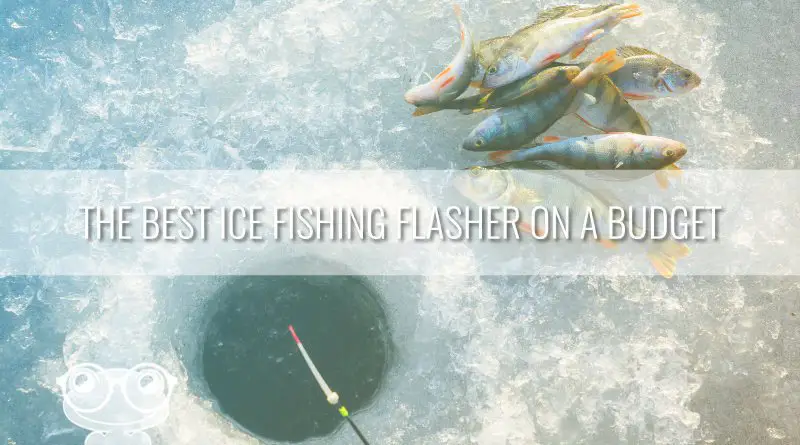Last modified on April 28th, 2022 at 8:05 pm
7 Best Ice Fishing Flashers on a Budget
We have caught fish for food for thousands of years. There have been many different methods of catching fish, and one of those methods is ice fishing.
Native peoples of North American and Canada would break the ice on a lake with a cordless drill ice auger and place a wooden decoy, shaped like a fish, into the hole. When a real fish would come to snag the decoy, they would spear the fish, using a spear made of wood, bone or ivory.
Over the years people started using rod, line and hook to catch fish and will often set up inside of a modern ice fishing shelter for a month . Today’s ice fishermen will fish mainly for sport, and will have many more sophisticated devices at their disposal. One of those devices is a fishing flasher.
Ice fishing flashers allow you to see exactly what lies beneath the hole that you are fishing in. The way a fishing flasher works is by measuring the density of what lies beneath the unit, which it then displays on a screen. The denser the object, the bigger the image and the darker the color of the object shown on the screen.
A flasher is a portable sonar unit. It will use a three color system to gauge depth and movement. The flasher gives the fisherman an idea of what is going on beneath the ice.
Flashers are designed to be able to fish vertically and they have the ability to be more sensitive in picking up tiny jigs. The built in flashers and sonar allow for better target identification. It is relatively easy to operate a fishing flasher, and easy to read once you get the hang of it.
We have reviewed 7 ice fishing flashers that might fit your budget, and have listed the results below. Whether you pursue ice fishing avidly, or only once in a while, an ice fishing flasher can help you make the most of your time on the ice.
Buyer's Guide Table of Contents
Product | Summary |
|---|---|
Garmin Striker 4 with Transducer | Overall Rating - 4.5/5 Finding fish is easier than ever with the Garmin Striker 4 fishfinder. Mark and return to your hot spots, boat ramps and docks, and share your favorite waypoints and routes with other Striker and echoMAP combos. |
Garmin Striker 4 with Portable Kit | Overall Rating - 4.5/5 Striker 4 fishfinder with portable carrying case is perfect for fishing from a kayak or canoe and is especially handy for ice fishing. |
Deep Pro + Smart Sonar | Overall Rating - 4.0/5 What is the depth, bottom contour and water temp? How weedy is it? Just cast out your Deeper Smart Sonar PRO+ to get instant depth and water temperature readings. |
Hawkeye Fishtrax | Overall Rating - 4.0/5 The FishTrax 1 is for beginner anglers looking for affordability and ease of use. It has a VirtuView ICON LCD that depicts sonar data in a series of icons, which provides valuable fishing data in an easy-to-understand readout. |
HumminBird ICE-35 with Three Color Flasher | Overall Rating - 4.0/5 The new ICE HELIX G2 and G2N Series give you a deeper understanding of what’s below the ice, with exclusive features you won’t find anywhere else |
HumminBird ICE-45 Three Color Flasher with LCD | Overall Rating - 4.5/5 The ICE 45 flasher features a center dial LCD display that will provide a digital depth display and automatic depth scale and is engineered for peak performance in temperatures as cold as -20°. |
MarCum M Series Flashers | Overall Rating - 4.5/5 The MarCum M Series Flashers have become a go-to for many hard water anglers that refuse to compromise. |
PRODUCT REVIEWS
BEST ICE FISHING FLASHERS ON A BUDGET
Features
From the Manufacturer's website:
"Smooth Scaling graphics provide uninterrupted imagery when switching between depth-range scales. Sonar history rewind allows you to scroll back through sonar images to mark waypoints you originally may have missed. Plus, it has a built-in flasher and displays speed data. Includes tilt/swivel mount, CHIRP (77/200 kHz) transducer with transom and trolling motor mounting hardware and cable.”
Pros:
Sonar gives clear images
Has a keyed interface, with dedicated buttons
Continually sweeps frequencies, which provides wider range of info
Cons:
Customer service needs improvement
Connectors are too easily dislodged
Features
From the manufacturer's website:
“Mark and return to your hot spots, boat ramps and docks. You also can share your favorite waypoints and routes with other STRIKER and echoMAP chartplotter combos. Smooth Scaling graphics provide uninterrupted imagery when switching between depth-range scales. Sonar history rewind allows you to scroll back through sonar images to mark waypoints you originally may have missed. Includes carrying case, rechargeable battery, CHIRP (77/200 kHz) transducer, tilt/swivel mount and transom and trolling motor mounting kit.”
Pros:
Can use for shore, boat or ice fishing
Syncs to your smartphone or tablet using WiFi (like a hotspot)
Scans down to 260 feet.
Cons:
Battery life is about a year
Unit needs to be shipped to company for battery to be changed
Features
From the manufacturer's website:
"Once you are retrieving your Deeper PRO+, it pinpoints the features fish love, like humps, depressions and marginal shelves. You will see the weed location and its thickness. Deeper, also, helps you to discover if the bottom is hard or soft, with gravel or silt. As the Deeper PRO+ is a sonar, you can even locate the fish themselves. So, if you’ve baited an area, you can monitor if the fish are staying there or moving elsewhere.”
Pros:
Can use for shore, boat or ice fishing
Syncs to your smartphone or tablet using WiFi (like a hotspot)
Scans down to 260 feet.
Cons:
Battery life is about a year
Unit needs to be shipped to company for battery to be changed
Features
From the manufacturer's website:
"The FishTrax 1 also includes 5-level adjustable sensitivity, an audible fish alarm and a backlit display for easy night time viewing.The FishTrax 1x is for intermediate anglers looking for advanced features to pinpoint optimal fish habitats. It incorporates a VirtuView Dot Matrix LCD that can be adjusted to show raw sonar data, or the FishTarget programming can be turned on to pinpoint the exact depth of your prey. The FishTrax 1x also includes auto-switching, dual-beam FishTrax. Intelligent Sonar, as well as a 10-level sensitivity adjustment, multi-level depth ranges, and auto-zoom bottom tracking. Integrated fish and depth alarms intensify prey targeting even further.”Pros:
Works in a canoe or kayak
Easy to use, and accurate
Less expensive that other units
Cons:
Does not work as well in silt
Not waterproof, just water resistant
Features
From the manufacturer's website:
"Dual Spectrum CHIRP Sonar, unprecedented viewing options specifically for the ice angler, built-in GPS with Humminbird Basemap, plus CHIRP Interference Rejection settings. And, once the ice thaws, you can transfer your ICE HELIX to your boat for summer fishing by adding an optional transducer, or using the one that comes with your ICE HELIX 7 G2N All Season model. No matter how you fish, the ICE HELIX 7 and 5 will revolutionize the way you see the water.”
Pros:
Users feel that they definitely catch more fish when using this unit
Digital readings make it easy to read under various conditions
Easy to assemble
Cons:
Not most responsive customer service
Not the best separation
Features
From the manufacturer's website:
“Our Dual Frequency Sonar delivers user-selectable beam options to fine-tune your sonar coverage to keep you zoned-in on the fish. The three-color, fiber optic display shows you the lake bottom and marks the fish and your lure below.”
Pros:
- Little, if any, interference
- Great sensitivity
- Screen and jig reaction time is instant
Cons:
- If needed, cannot buy parts, need to send unit in for repair
Features
From the manufacturer's website:
Quiet, the MarCum M Series feature brushless motor designs so they are dead quiet and produce bright, crisp marks to separate fish, baits and bottom. Loaded with helpful features like split screen options, noise rejection settings and selectable depth ranges, if you want to up your ice-fishing odds, you should consider the MarCum M-Series. It received 4.7 stars out of 5 stars by reviewers who purchased and used the MarCum M series.”
Pros:
Marks fish easily, and picks up small jigs
Clear and definite marsk
Easy to use and quiet
Cons:
No battery indicator
Can be hard to read if in glare
Features
83%Cotton, 10%Polyester, 7% Lycra
Imported
Absorbent,breathable, and quick-drying,elastic
Includes two 3.7V 2200MAH rechargeable Li-ion batteries
3 Level Temperature Setting
You can charge electric socks anytime and anywhere with USB rechargeable batteries
One size,bottom length is from 22cm/8.66inch to 29cm/11.42inch,tube height is 23.5cm/9.25inch.
Hand wash
A flasher can look like a complicated piece of equipment that a person would need an inch thick manual and higher education to be able to decipher. But it is really not.
One important thing to understand about an ice fishing flasher, is that a flasher does not attract fish to an area, they simply allow you to see what is beneath the ice where you have chosen to fish.
We had mentioned previously in this article that flashers are portable sonar units. You will have a display that allows you to see the bottom of the water, your jig and any fish that pass under the beam of the sonar.
The display on the flasher will show a variety of colors that are a bit hard to interpret, unless you are familiar with using this type of equipment.
The denser an object is, the wider the signal and the color will also change. The color will change from green to yellow and then to orange.
Please check out the video below. It is one of the clearest explanations for how an ice flasher works that we have heard to date.
HOW TO USE A FISHING FLASHER
These are the basic steps to using an ice fishing flasher:
Put the Transducer in the water
Once you have your ice fishing flasher setup according to the manual’s instructions, lower the transducer into the hole that you have made in the ice. Try and make sure that the transducer sits below the bottom of the ice edge.
The reasoning behind this placement is that it will prevent the sonar from bouncing off the sides of the ice hole. It would create a muddled image if the signals bounce off the sides of the hole.
Set the Depth
Flashers have the capability of reading anywhere from one foot to 250 feet of water. If you know the depth of the water you are fishing, it can be helpful. If you don’t know this offhand, ask others or looking online for hydrographic maps of the lake.
Set the flasher’s bottom depth to one step above the water depth. So if you are fishing on a lake that has a depth of 30 feet, you would set the flasher at 34 feet.
Tune the Gain
The transducer uses power to create a picture of what is going on under the ice. That power is called the “gain”. When the sonar signal leaves the transducer, it travels down in a cone shape and bounces off objects until it hits the bottom.
At that point, the signal will bounce back to the surface. If the water that you are fishing in is deep, the transducer will need more power to bounce the sonar off of the bottom.
Start the tuning process by turning the gain up until you see a lot of interference. Start to slowly turn the gain down until the screen begins to clear.
Tuning the gain in this manner allows you to maximize the gain with minimal interference. It gives you the best chance of seeing if anything enters the column of water you are monitoring.
Using the Zoom
Maximizing the resolution and sensitivity of what is being displayed on the flasher is the job of the zoom. The zoom allows you to focus on specific depths of water where certain types of fish might be present. The zoom will operate in a different manner depending on the type of flasher, so consult the manual that comes with your equipment.
Commence Fishing
The best way to get comfortable and familiar with a flasher is to use it. A little bit of time and practice will help you to appreciate what a flasher can do to improve your chances for a successful fishing trip.
Drop your lure down the hold and you should be able to see it clearly on the screen. It will be represented as a bar. Make that bar as thin as possible by further fine tuning the gain. The reasoning behind this tactic is so that you can distinguish your lure from any other movement on the screen.
At this point, any other line that you see between the bottom and the ice is either baitfish or the best fish you ever caught.

















